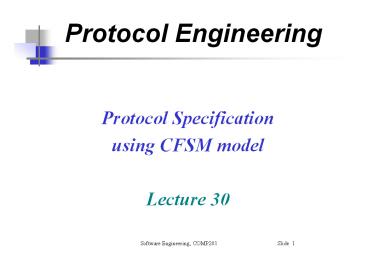Protocol Engineering - PowerPoint PPT Presentation
Title:
Protocol Engineering
Description:
Example 3: An aggressive protocol with a self-sending loop. ... The non-determinism in the execution of transitions of a mix node may result in ... – PowerPoint PPT presentation
Number of Views:276
Avg rating:3.0/5.0
Title: Protocol Engineering
1
Protocol Engineering
- Protocol Specification
- using CFSM model
- Lecture 30
2
Protocol Engineering
3
The sequence chart is good at capturing the
normal/specific scenario of system interactions.
It is difficult to show several/all possible
scenarios simultaneously on a chart and that
often leads to ambiguity in the specification.
4
The use of Formal Methods
- Provide a formal and unambiguous way of designing
and documenting protocols. - Allow formal analysis (verification/validation/per
formance analysis) before protocols are
implemented. - Allow automatic and direct generation of
executable programs from the formal
specification.
5
Specification Languages
- Informal methods
- such as the sequence chart
- Formal methods
- State Transition Models -- Finite State Machines
(FSM), -- Communicating FSM (CSFM), -- Petri
nets - Programming Languages Models -- Abstract
Programs -- CCS (Calculus of Communicating
systems), CSP -- Temporal logic - Hybrid Models -- Extended FSM (EFSM)
Language Standards - SDL (FSM extensions) -
Estelle (EFSM extended Pascal) - LOTOS (CCS) -
ASML
6
Communicating Finite State Machines (CFSM)
- Protocol is described as a set of Communicating
Finite State Machines. - Each CFSM represents a component (or process) of
the network (in OSI term, a protocol entity, e.g.
sender, receiver). - Each CFSM is represented by a directed labelled
graph where - Nodes represent states (conditions) of the
process - Edges represent transitions (events) of the
process.
7
Transitions
- Transitions include actions
- taken the process (e.g. the sending a message) or
- external stimuli (e.g. the reception of a
message). - The sending message transition is labelled as
-Msg - where Msg is the type of messages being sent.
- The receiving message transition is labelled as
Msg - where Msg is the head message on the incoming
FIFO queue of the CFSM
8
Network of CFSMs
B
A
C
9
CFSM operating semantic
- The channels that connect CFSM's are assumed to
be FIFO queues. - An error-prone channel is modelled as a CFSM.
- Initial node--starting state of a CFSM.
- Final node -- no transition.
- Receiving node -- all (outgoing) transitions are
receiving transitions. If no message or incorrect
msg in the channel, the node will be blocked. - Sending node -- all transitions are sending
transitions. They are not blocked. - Mix node -- has both receiving and sending
transition.
10
- Starting at the initial node, a CFSM traverses
the nodes and transitions. - The node currently being visited is called the
current node. - When a machine traverses a sending transition, it
sends/appends a message with the same label to
its outgoing channel. - A machine at a node cannot traverse its receiving
transition unless there is a message matched with
the same label on the head of its incoming
channel. - When a machine traverses a receiving transition,
it removes the matched head message of its
incoming channel. - Among several possible transitions, a machine
traverses one non-deterministically
11
Networks of CFSMs
- Example 1 Simple request-response protocol.
- Example 2 What happens if we change the initial
node of a CFSM?
12
Networks of CFSMs
- Example 3 An aggressive protocol with a
self-sending loop.
13
Networks of CFSMs
- Example 4 A simple sliding window protocol with
a window size of 2.
14
CFSM Modeling Exercises
- How to specify the channel behavior as a CFSM
which - loses every other packet,
- loses packets sometimes,
- loses and corrupts the packet sometimes?
15
CFSM Modeling Exercises
- How to extend the model to specify CFSMs with the
multiple channels?
16
Pros and Cons of the CFSM model
- CFSM deals only with the state-transition aspect
of protocols - it does not address the data aspect of protocols,
e.g., message content or format. - It can not handle protocols where state variables
have a wide range of values. - Extended FSM were proposed but EFSM becomes
difficult to analyse. - The FIFO channels assumption in CFSM is very
powerful, - just think about how to model an unbounded or
even a large buffer using Petri net.
17
Pros and Cons of the CFSM model
- CFSM is an abstract model.
- The non-determinism in the execution of
transitions of a mix node may result in different
implementation. - You can always expand the specification, e.g.,
replacing node 1 with a subgraph
18
The Alternating Bit Protocol as CFSMs
- The Alternating Bit Protocol is used to guarantee
the correct data delivery between a sender and
receiver connected by an error channel that loses
or corrupts messages. - It got the name since it uses only one additional
control bit in the message and this control bit
only alternates when the previous message is
correctly received.....
19
The Alternating Bit Protocol
20
Outline for the next lecture
- Verifying the Alternating Bit Protocol
- Protocol Verification using Reachability Analysis
- Protocol Design Errors
- Protocol Verification Exercises
- Pros and Cons of Reachability Analysis
- Tools for specification development































